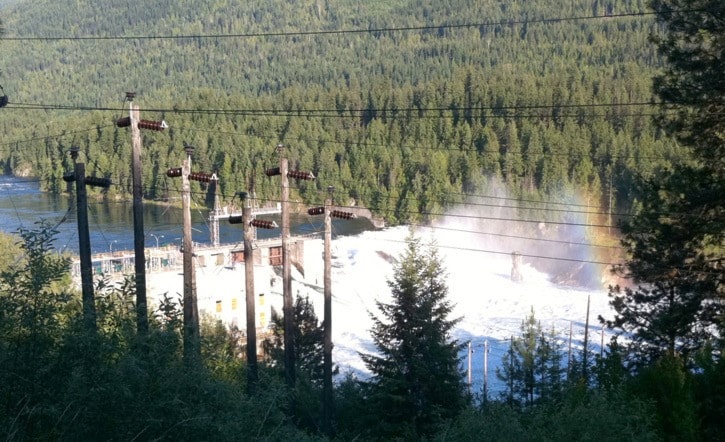Ispent the past couple of weeks camping in the Kootenays. If I had to name the trip in retrospect, I’d call it the dam flood tour.
Lakes, reservoirs, rivers and streams lapping at their banks caught my attention at every turn.
The beach at Beaton was gone. The dock at Trout Lake was a fair wade away. The Lardeau River coursed along, nibbling at the edge of Highway 31 for parts of the route. The northern reaches of Kootenay Lake near Johnsons Landing was choked with logs and debris – from a distance, it looked like the remains of a few galleons lost in a sea battle. To the chagrin of camping kids, the lake had reclaimed the jungle gym playground at Kokanee Glacier Provincial Park. Sunbathers had to make due with a sliver of sand at Rotary Lakeside Park in Nelson. In Castlegar, our hike was kiboshed when we discovered the approach was waist deep. Small trees and park benches around Castlegar’s Zuckerberg Island were completely submerged, the river swirling and eddying around it forcefully. At Syringa, children mounted the many floating logs at the beach shore to play joust – they were floated from the shore by high water levels. As we waited to board, the captain of the cable ferry at Fauquier let his passengers off, then backed up, dialled it to ramming speed and shoved the metal on-ramp up the concrete ramp a few more feet to accommodate the rising water. The high levels were too much for the Arrow Park ferry; it is out of service until waters recede. In Nakusp, the lake was only several steps away from the waterfront walkway. On the way home at Galena Bay, the ferry made a few wide turns to avoid a constellation of logs and stumps. Early Sunday morning I returned to Revelstoke Dam to get more shots of epic spilling there, this time under sunny conditions.
We passed four dams along the way; all of them frothed as they generated and spilled copious amounts of water. To boot, most of them generated their own rainbows.
VIDEO: The Revelstoke Dam spills on the morning of July 15, 2012.
The river, road and rail intersection
The completion of the Trans-Canada Highway through our town 50 years ago put an ongoing shift in Revelstoke’s orientation into high gear. In our early modern history and prehistory, our orientation was north-south. The Columbia River was the transportation route. We were connected to the people of the Lardeau, Upper and Lower Arrow Lakes, the Slocan, Trail and beyond to Spokane and all the way to Portland and the Pacific by the river and lakes systems, as were the First Nations peoples for thousands of years.
Then came the railway, making us a hub, a connection point to the east and west. The highway reinforced this new orientation, better connecting us with the Shuswap, Okanagan, the Coast, Alberta and all points beyond by auto.
What is Revelstoke’s karass?
Reading Alex Cooper’s story about proposed federal boundary changes for the Kootenay-Columbia riding got me thinking about where we should “be” – where Revelstoke belongs. I don’t have a strong opinion on where to draw a new line (other than to agree with MP Alex Atamanenko when he says splitting up Castlegar and Nelson is crazymaking.) What I do believe in is any and all effort to maintain, bolster and improve any connection we have with the Kootenays – the lands south of here. It’s our karass, as novelist Kurt Vonnegut put it with his tongue in his cheek – a karass is a group of people connected by destiny, connected together to perform God’s will.
F-350s with headache racks and tidy tanks. Rednecks versus hippies. Subarus with ski stickers. Calling that dirt goat track a “highway.” Long memories. Logging trucks. Sawmills. Mountains, mountain men and women. Dams. Trees, trees, trees. Pockets of valley agriculture. The knowledge and community necessary to eke out a living in that environment. And especially the waterways that connect it all. That’s the Kootenay-Columbia karass.
Every time someone, somewhere else decides to take a stab at creating a jurisdiction with Revelstoke in it (healthcare, environment, transportation, forestry, education, political) we should take notice. They usually get it partly wrong.
Granfalloon
Overlooking a sun-baked Osoyoos from the cliffs above, it really looked like a science-fiction landscape. 38 degrees Celsius that day. Vineyards filled with migrant workers. Spanish-styled wineries. As we proceeded into the Okanagan, it became clear to me where Revelstoke isn’t. To identify with that region would be, as Vonnegut put it, a granfalloon – a false karass – people who think they have a connection that doesn’t actually exist.
Regional treasure Milton Parent passes away
A littler-known fact about me in Revelstoke is I also serve as managing editor of the Nakusp-based Arrow Lakes News, and have for almost seven years. Historians will note the passing of Nakusp’s Milton Parent early last week. If you didn’t know of him, read up. The man was a living treasure for the region, as he chronicled the early modern history of the area, especially the Lardeau region and in Nakusp. An accomplished writer, he published several historical books on the region, including Faces of the Past, Silent Shores and Sunken Ships, Port of Nakusp, Bugles on Broadway, Halcyon: The Captain’s Paradise, Caulkboot Riverdance, and Circle of Silver. Circle of Silver earned him the Lieutenant-Governor’s medal from the BC Historical Federation in 2001.
Parent ran the Arrow Lakes Historical Society and was an accomplished archivist, collecting thousands of images, documents and audio interviews of the region. His passing creates a giant hole of historical knowledge, especially in the early history of the region that connects Revelstoke to the Kootenays. He will surely be missed by many.
